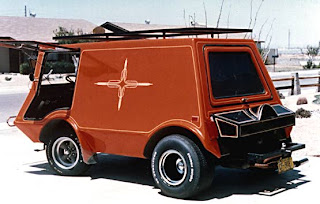After the body is removed, the chassis is shortened 16-1/2 inches to give the finished van the ability to traverse rough terrain without bottom out. Because the drivetrain is in the rear, shortening the chassis amounts to little more than taking a 16-1/2-inch slice out of the center and welding it together again. The shorter wheelbase also makes the van more nimble, both on and off the road. Two steel roll bars serve a station formers when the body is built, and they add extra strength to the finished van. The roll bars are glassed in place and become a permanent part of the body. The new body is anchored to the chassis by bolts around the perimeter and at the base of the roll bars.
A carpeted floorboard, hinged down the center, is located at the widest point of the van. The two half-sections fold up on either side for access to 34 cubic feet of storage space underneath (retrieve drawing in the left margin to the left for more details). The floorboard also serves as a sleeping platform with enough room for two adults.
Boonie Bug served as a test bed for the automotive application of the fiberglass-over-foam composite, which is explained in detail in the document entitled One-Off Construction Using FRP/Urethane Foam. It also appears in a number of scenes in the movie Total Recall. Although it was repainted and upgraded to 21st-century Martian specifications, it is still recognizable as the only van in the movie with a square-tube rack on top.



No comments:
Post a Comment